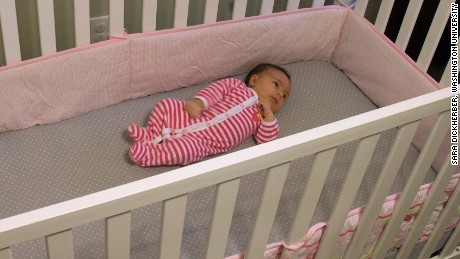Story highlights
- Crib bumpers were involved in 77 possible deaths between 1985 and 2012;
- The American Academy of Pediatrics Safe to Sleep Campaign suggest no soft bedding, including bumpers be used in the crib
- There are no federal regulations restricting the use of bumpers
(CNN)Worried about a significant uptick in infant deaths, doctors want parents to stop using crib bumpers.
The number of babies who have died because of this common crib bedding has tripled in the last seven years of data available. That's according to authors of a study that looked at infant deaths since 1985.
Between 1985 and 2012, bumpers possibly were involved in 77 deaths, according to a study running in the latest edition of the Journal of Pediatrics. Of deaths that were suffocations, 67% were by a bumper alone (not clutter in the crib) and 33% happened when a baby got wedged between the bumper and another object. The authors analyzed records from the U.S. Consumer Product Safety databases and the National Center for the Review and Prevention of Child Deaths. The uptick in reports may be due to better awareness among doctors, but overall the authors believe these numbers are still "dramatically" undercounted.
There are no federal regulations restricting the use of crib bumpers. There are industry standards that companies can follow voluntarily. For instance, companies no longer sell plastic bumpers and the fabric bumpers are thinner than they once were.
But bumpers have been considered such a problem that Chicago and the state of Maryland ban bumper sales in stores. The American Academy of Pediatrics has advised parents not to use them, including the newer breathable mesh bumpers, and pediatricians regularly warn parents about them. In 2012, Consumer Reports put bumpers on the "13 dangerous baby products to avoid" list. However, the industry still considers them safe and you can buy them in nearly any baby store. For that reason, study co-author Dr. Brad Thach, a pediatrician and professor at Washington University in St. Louis, argues more needs to be done.
"You go into any store and you see all these cribs with bumpers and you see where people would assume if they weren't safe, stores wouldn't be selling them," Thach said. "People think they are buying a product that's protecting their infant from hurting themselves, but bottom line is they serve no real purpose."
While babies may be able to bump their heads on the sides of a bumperless crib, infants don't have enough force to cause significant injury. The injury would be a bump or a bruise, Thach said. When death certificates or investigation documents specifically list the crib bumper as the cause of death, children typically were smothered between the bumper and a part of the crib, they choked on the bumper ties, or an older child used the bumper to climb out of the crib and fell on his or her head.
This is not the first time Thach and his co-authors have tried to raise awareness of this problem. A study he did in 2007 found 27 accidental deaths attributed to bumper pads. At the time, the authors called on the Consumer Product Safety Commission to restrict use. The department took no action. The industry did voluntarily make the bumpers thinner. But the latest study says there have been deaths since that time and Thach argues making bumpers thinner is not enough. "Any death is significant and these are preventable deaths," Thach said.
Asked about the study, the Juvenile Products Manufacturers Association, which represents the industry, sent a statement. "JPMA affirms that when used according to manufacturer's instructions, traditional crib bumpers that meet the ASTM Infant Bedding Standard assist parents in addressing their very real concerns about crib injuries including limb entrapment, head injury, contusions and abrasions."
The association mentions an earlier independent research report from 2013 that evaluated all available information at the time, including incident reports and allegations, and says it "found that at no time has the crib bumper been cited as the sole cause of an infant's death." A cursory look by CNN at CPSC data shows several records available online that do mention bumper pads.
Lorena Kaplan, the Safe to Sleep Campaign lead at the National Institute of Child Health and Human Development, said there is some variation on data collection in general, but her organization suggests parents follow the American Association of Pediatrics guidelines.
"I think based on the best data we have now, we are saying no to any kind of soft bedding, including bumpers, should be included in the crib," Kaplan said. Even if bumpers are still easy to buy that doesn't make them a good option, she said. "You can walk into a store and buy cigarettes, too, but that doesn't necessarily mean they are good for you."
If you are concerned about a baby getting limbs stuck between the slats, there is no formal recommendation from any of these groups on how to prevent that. Study co-author Thach is a grandfather and he does have some empathy for concerned parents. When his grandchild got an arm or leg stuck outside the crib, "there was yelling."
But the danger is so clear, he said, "There are still no bumpers allowed in the greater Thach family."






